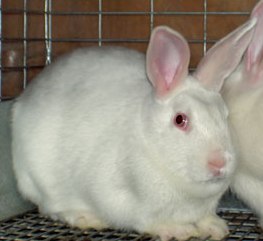RABBITS PRODUCTION REVIEW
Rabbits are a quick-breeding source of low-fat, high-protein meat and have long been enjoyed as a food by many people across the world. A fine-grained white meat, it can be substituted for chicken in many recipes.
Until the increase in beef consumption in the 1960s, rabbit was popular in the United States. Today, the interest in lower fat diets and healthy eating combined with an ongoing pursuit by chefs and foodies of novel and locally produced foods has led to a domestic resurgence in the use of rabbits for meat.
The two most common types used for meat production are New Zealand whites and Californians.
Read also: 8 common rabbit diseases and how to treat them
Rabbits can be produced for many different markets: for breeding stock, as medical and educational lab animals, for pet food, as pet and show animals, and for their wool and skin. While these may be pursued as a secondary market for rabbit farmers, the focus of this article is on meat production.
 Learn More
Learn MoreProduction
U.S. Ag Census data shows that rabbit production is up. In 2012, more than 5,000 farms sold nearly 853,000 rabbits.
Marketing
Rabbit has appeal across many ethnic markets. Muslims, Christians, and Hindus do not have religious prohibitions from consuming rabbit meat. However, because of their popularity as pets, there is one factor that is difficult to counter: the Easter bunny image. Some meat eaters may be squeamish about consuming an animal that others keep as pets in their home. And in spite of their toothy image, they are not rodents.
Fortunately, these images have not dissuaded chefs across the country from adding rabbit meat to their menus. Today, rabbit meat can be found on many menus in restaurants in the interior of the United States—from Atlanta to Chicago to St. Louis to Austin.
Online retail prices for dressed rabbit vary widely–from $6.59 to more than $18 per pound. Due to their prolific breeding capabilities, it is essential that a market be available before commencing wide-scale rabbit production. Rabbits have a slim profit margin and producers are advised to start small, using rabbits as a supplemental income source while they are establishing their market.
Read also: Choosing the right rabbit cage and hutch
Processing
Since they are not classified as livestock, rabbits are exempted from USDA inspections on slaughter. Grades for rabbit meat were removed in 1995. However, they are protected under the Animal Welfare Act that requires that all individuals or businesses dealing with rabbits must be licensed or registered with APHIS.
Some producers slaughter their own rabbits for direct sales. Rabbits may also be commercially slaughtered in accordance with state, county or municipal guidelines. A limited number of commercial slaughter facilities exist across the United States. Small-species mobile processing facilities may help fill the need for producing fresh rabbit meat in sufficient quantities for a limited market.
American Rabbit Breeders Association – The association’s membership totals over 30,000 throughout the United States, Canada and abroad.
Read also: Feeding management for rabbits
Global Agricultural Trade System (GATS), Foreign Ag Service (FAS), USDA.
Guidelines for Entry into Meat Rabbit Production, Alabama Cooperative Extension System, Alabama A&M and Auburn Universities, revised 2016 – This article provides some basic guidelines about getting started in the meat rabbit business.
Mobile Slaughter/Processing Units, Cooperative Extension Service, University of Kentucky and Kentucky State University.
Rabbit Hemorrhagic Disease, Center for Food Security and Public Health, Iowa State University, 2016.
Rabbit Production, Pennsylvania State University Agricultural Research and Cooperative Extension – Provides information to evaluate initial resources needed.
Raising Rabbits on Pasture, Maine Organic Farmers and Gardeners Association, 2009.
Small-Scale Sustainable Rabbit Production, ATTRA, National Sustainable Ag Information Service, NCAT, 2012 – This publication focuses on meat rabbits and sustainable rabbit management.
United States Classes, Standards, and Grades for Rabbits, Ag Marketing Service, USDA.
For more information and updates join our WhatsApp group HERE
Follow us on Twitter Here











